Resistant tomatoes with high yields for greenhouses and soil - “Golden Domes” tomato
The exquisite name for Golden Domes tomatoes did not arise by chance. At one time, Vladimir Vysotsky sang: “The domes in Russia are covered with gold so that God will notice more often.” It is not surprising that this variety name attracted the attention of a huge number of vegetable growers. In all regions of our country, the beds were decorated with these tomatoes.
The culture has proven itself to be cold-resistant, large-fruited, high-yielding and resistant to major diseases of the Solanaceae family. But the main highlight is hidden in the taste of ripe fruits, the pulp of which practically does not contain sour tomato juice. This means that these tomatoes are ideal for dietary nutrition and for people with high acidity.
Characteristics and description of the variety
The variety belongs to the “Siberian Garden” tomato series, whose second name is “Siberiada”. This is the result of long and painstaking work of Siberian breeding scientists. After many years of testing, the Golden Domes tomato was included in the State Register in 2005 and patented as a breeding achievement.
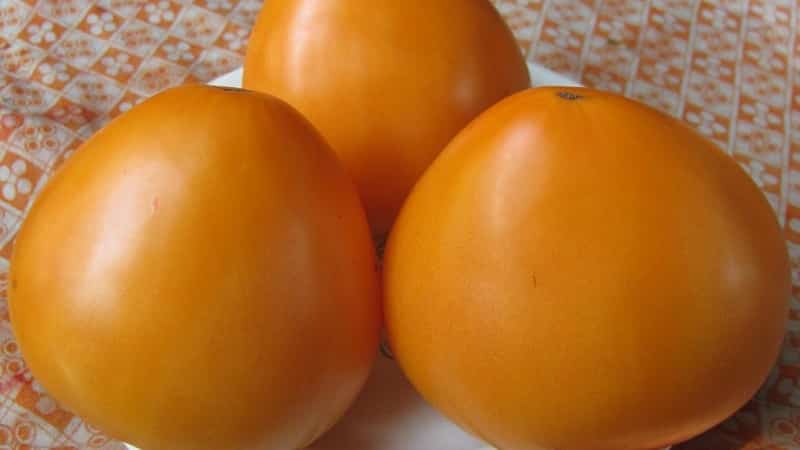
The seasoned Siberian character of culture is manifested in the ability take root in beds in those regions where other varieties die even in greenhouse conditions.
Determinate bush, 90-150 cm high. In a greenhouse its height is greater than in open ground.
Leaves are medium sized, bright green. The inflorescences are simple. The first inflorescence is laid above the 8th leaf, the subsequent ones - every 2 leaves.
It does not belong to the standard species, therefore it requires certain care. The main difference from the standard ones is the weak stem. Therefore, a garter is necessary, otherwise the stems will begin to break from the weight of the fruit.
Degree of ripening - medium, from the appearance of the first shoots to ripe vegetables, 110-117 days pass.
Productivity is high: 10-13 kg per 1 sq. m. Resistant to many tomato diseases.
The fruits are large, average weight 500 g, crack due to over-ripening, lack of moisture and nutrients.
Reference! From the first inflorescences, the weight of the fruit reaches up to 800 g, and from the very last - no more than 300 g.
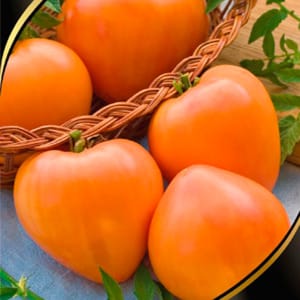 The color is bright orange with a hint of yellow. The shape resembles the domes of churches.
The color is bright orange with a hint of yellow. The shape resembles the domes of churches.
In the Foto Golden Domes tomatoes presented.
The taste is sugary, without pronounced acidity. The fruits are rich in carotene and lycopene. There are four cameras. There are few seeds.
Ideal for fresh summer salads. Also used for making sauces, adjika, lecho and juice. Suitable for dietary dishes.
Ripe vegetables cannot be stored, they are immediately processed for preparations or consumed fresh.
How to grow seedlings
The soil mixture is prepared for seedlings in the fall: 2 parts of garden soil are mixed with 1 part of two-year humus and 1 part of river sand. Place them in wooden boxes and leave them until spring. It is recommended to keep the boxes in the cold, since freezing the soil disinfects it. Sowing of seeds is carried out 50-55 days before planting seedlings in the ground. In terms of timing, this is the end of February - beginning of March.
For greater germination, seeds are placed in a growth stimulator overnight. The day before sowing, the boxes are brought into a warm room so that the soil warms up.
The earth is leveled and grooves are made with a distance between them of 5 cm and a depth of 1 cm. The furrows are lightly watered and seeds are placed in them at a distance of 1 cm from each other. Sprinkle the grains with soil and water moderately again. Cover the boxes with film or glass; this simple method helps protect the soil from drying out. The boxes are placed in a warm place where the air temperature is not lower than 23 degrees.
After 5-7 days you can see the first shoots, after which the boxes are immediately moved to a well-lit place. This could be a window sill or artificial lighting lamps.
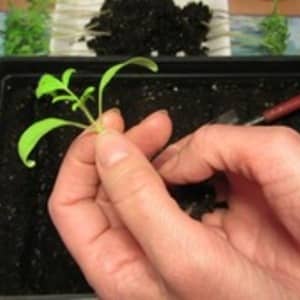 The main point in caring for sprouts — moistening the rows as necessary. After moistening, loosen to ensure access of oxygen to the roots.
The main point in caring for sprouts — moistening the rows as necessary. After moistening, loosen to ensure access of oxygen to the roots.
Picking is carried out when 2 true leaves appear. They are picked into a larger box with a row spacing of at least 8 cm. The distance in the row between seedlings is at least 3 cm. At the time of picking, it is advisable to carry out the first fertilizing with complex minerals.
The photo shows a selection of seedlings.
Seedlings do not require mandatory hardening, but to get the sprouts accustomed to outdoor conditions, it is recommended to take them out into the open air for a while.
Reference! Since the crop is not a hybrid, you can select the seeds for the next planting yourself.
How to grow tomatoes
The seedlings are ready for planting in a permanent place in 50 - 55 days. Fertilizers such as humus, compost or peat are first added to the soil.
Tomatoes need to be planted in two rows, and the seedlings of the first row in relation to the seedlings of the second row are arranged in a checkerboard pattern. The distance between bushes is at least 50 cm, and between rows - 40 cm.
Watering is most important during the flowering and fruit set stages.. Without a sufficient amount of moisture, pollination will not occur, and those fruits that have time to set will not gain weight. Water tomatoes at the root, which prevents fungal diseases.
Water 2 times a week in the evening, 2 liters of water for each seedling.. A good conductor of water is an ordinary plastic bottle without a bottom. It is installed at a shallow depth in the root zone and filled with water, which gradually penetrates to the roots.
After watering, weeding and loosening of the soil is necessary.. These simple steps not only provide oxygen access to the roots, but also help in pest control.
Mulching beds with straw is another preventative measure, which keeps the beds moist longer.
Determinate plant requires obligatory garter, since heavy fruits can break not too powerful stems. Vertically stretched ropes or wooden stakes serve as a strong support.
In addition to the garter, mandatory stepsoning is required.
Reference! Pinching is carried out to obtain more fruits from each bush.
Pinching involves removing additional stems, which appear in the axils between the main trunk and the tomato leaf. In one season there are up to 50 stepsons on a plant. If they are not removed, then the excess of branches will not allow the fruits to gain the proper weight.
Vegetables planted in street beds, lead into 3-4 fruit stems, and in a greenhouse - into 1 stem. Growing in a greenhouse involves dense planting and tying to a rope support.
Reference! Tomato Golden Domes has established itself as a species for open ground. It is under these conditions that the best performance in all respects is observed.
The formation (stepchildren) of culture depends on the regionin which it grows. In the northern regions, the best fruiting rate is observed when growing in 2 trunks, in the southern regions - when growing in 3-4 trunks.
To limit plant growth pinch the top.
To achieve maximum fruiting, resort to specialized drugs. For example, boric or succinic acid increases the number of ovaries in each cluster, and growth stimulants (Biostin, Rhizome) help to quickly gain root mass.
Read also:
Why do summer residents love the Altai Orange tomato so much?
Diseases and pests
Despite its Siberian character, the plant is susceptible to diseases such as late blight, verticillium wilt, blossom end rot.
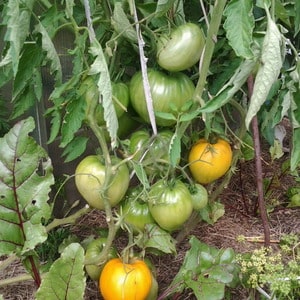 Fungicidal agents help in the fight against these diseases., for example, Oxycom. Treatment with fungicides is also carried out for the purpose of prevention.
Fungicidal agents help in the fight against these diseases., for example, Oxycom. Treatment with fungicides is also carried out for the purpose of prevention.
Calcium nitrate successfully fights blossom end rot, which is used to water and spray the plant.
In the fight against late blight, the main role is given to Bordeaux mixture or Fitosporin. These drugs destroy the cause of the infection, and the affected parts of the plant should be burned. Copper sulfate is used as a preventive measure against late blight.
As for insects, they are not averse to running around in vegetable beds and cause considerable harm to plants. These are known to every summer resident: mole crickets, spider mites, gnawing cutworms, Colorado potato beetles, and slugs.
Beds covered with wood ash and tobacco dust save tomatoes from pests, as well as regular inspection of bushes.
Slugs and Colorado potato beetles collected by hand, mole crickets are scared away from the beds by pungent odors.
Spider mite lives in a greenhouse, so there is a need for regular ventilation in order to destroy the conditions for the existence of the parasite.
Insecticides also help protect against parasitic insects.. But remember that treatment with them is possible 1 month before fruiting.
The nuances of growing in open ground and in a greenhouse
According to numerous reviews, the Golden Domes tomato is growing and developing more confident in open ground than in greenhouse conditions. However, the climatic conditions of many regions do not allow growing tomatoes outdoors.
If seedlings are planted in a greenhouse, they are placed more often than in open beds, since planting in a greenhouse implies thickening. The distance between seedlings is no more than 30 cm. The bushes are tied to vertically stretched ropes.
Outdoors, for garden beds, choose a sunny place blown by southern winds.. A light warm draft helps prevent fungal diseases.
In a greenhouse, the crop gains a height of up to 1.5 m, which does not happen in open ground.. To limit growth, pinching the crown is done. But it happens that the stem itself stops growing - it ends.
Harvesting and application
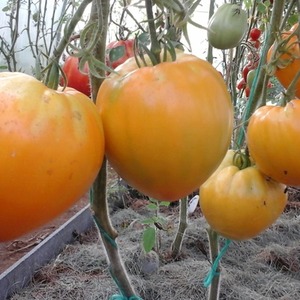 Fruit ripening begins in August. Beds with ripened golden tomatoes in the shape of church domes look very beautiful. Tomatoes should not be allowed to overripe as they may crack. Vegetables can be collected unripe; they will gain color on their own.
Fruit ripening begins in August. Beds with ripened golden tomatoes in the shape of church domes look very beautiful. Tomatoes should not be allowed to overripe as they may crack. Vegetables can be collected unripe; they will gain color on their own.
Do not forget that ripe vegetables of this variety cannot be stored.. The harvest is processed for winter harvesting, and some is left for fresh salads. Moderately juicy and dense, they perform well in lecho, juice, adjika and ketchup.They look original in fresh salads, complementing other vegetables perfectly.
Smaller tomatoes are selected for preparationsso as not to cut into several parts. And if you dilute orange tomatoes with red ones, then such a technique will be a worthy decoration for any feast. The fruits retain their taste well in barrel pickling.
The absence of tomato juice in fruits indicates a low acidity content, which allows you to use ripe vegetables for dietary nutrition.
Advantages and disadvantages
Orange tomatoes have many positive qualities:
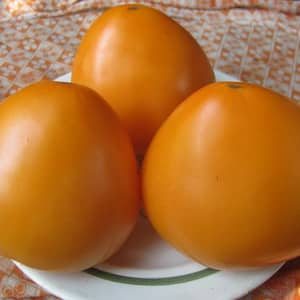 survival rate in all regions;
survival rate in all regions;- simple agricultural technology;
- average ripening time;
- possibility of growing without a greenhouse;
- resistance to major diseases;
- high fruiting rate;
- large fruits;
- excellent taste;
- unusual color and shape of tomatoes;
- suitable for dietary nutrition;
- You can select seeds for sowing yourself.
Negative qualities:
- Garter required;
- pinching and pinching are required;
- fruits cannot be stored;
- dependence of the appearance of the vegetable on the lack of moisture and nutrients.
More about tomatoes:
Tomato “Rosy cheeks”: reviews and photos
Stable and easy to care for, durable tomato "Zhenaros"
Unpretentious, but very tasty variety of tomatoes “Miracle of the Market”
Farmer reviews
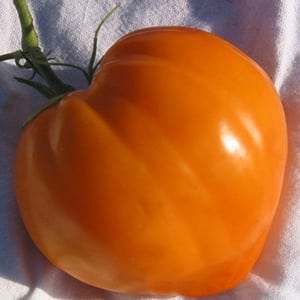 The opinions of vegetable growers about the taste sensations of Siberian tomatoes are varied. For some it is a honey sweetness, others perceive a grape note, others talk about a citrus aroma.
The opinions of vegetable growers about the taste sensations of Siberian tomatoes are varied. For some it is a honey sweetness, others perceive a grape note, others talk about a citrus aroma.
Perhaps the taste is influenced by different growing conditions of the culture, or maybe it’s a matter of everyone’s individual imagination.
Gardeners note a high quantitative indicator, which, of course, cannot be upsetting, despite the short shelf life of the fruit. They unanimously confirm the cold resistance of the crop, but there are two opinions about its susceptibility to diseases: some had vegetable plants that stood healthy and beautiful all summer, while others spent part of the season fighting infections.
Anastasia, Chelyabinsk: “I love large tomatoes. I have always grown Bull's Heart, but after meeting the Golden Domes, I don't look at other species. The care is simple, the results are stunning.”
Vasily, Novosibirsk: “I planted tomatoes in open ground, to be honest, I didn’t expect any special results in our climate. However, I was pleased with the harvest, and the fruits themselves are large, sweet and good in salads.”
Conclusion
The Golden Dome tomato has firmly established itself and continues to occupy a dominant position on farms and summer cottages. Its high yield, resistance to changes in weather conditions, simple agricultural technology, disease resistance and delicious taste are winning more and more new fans in all regions of our country.